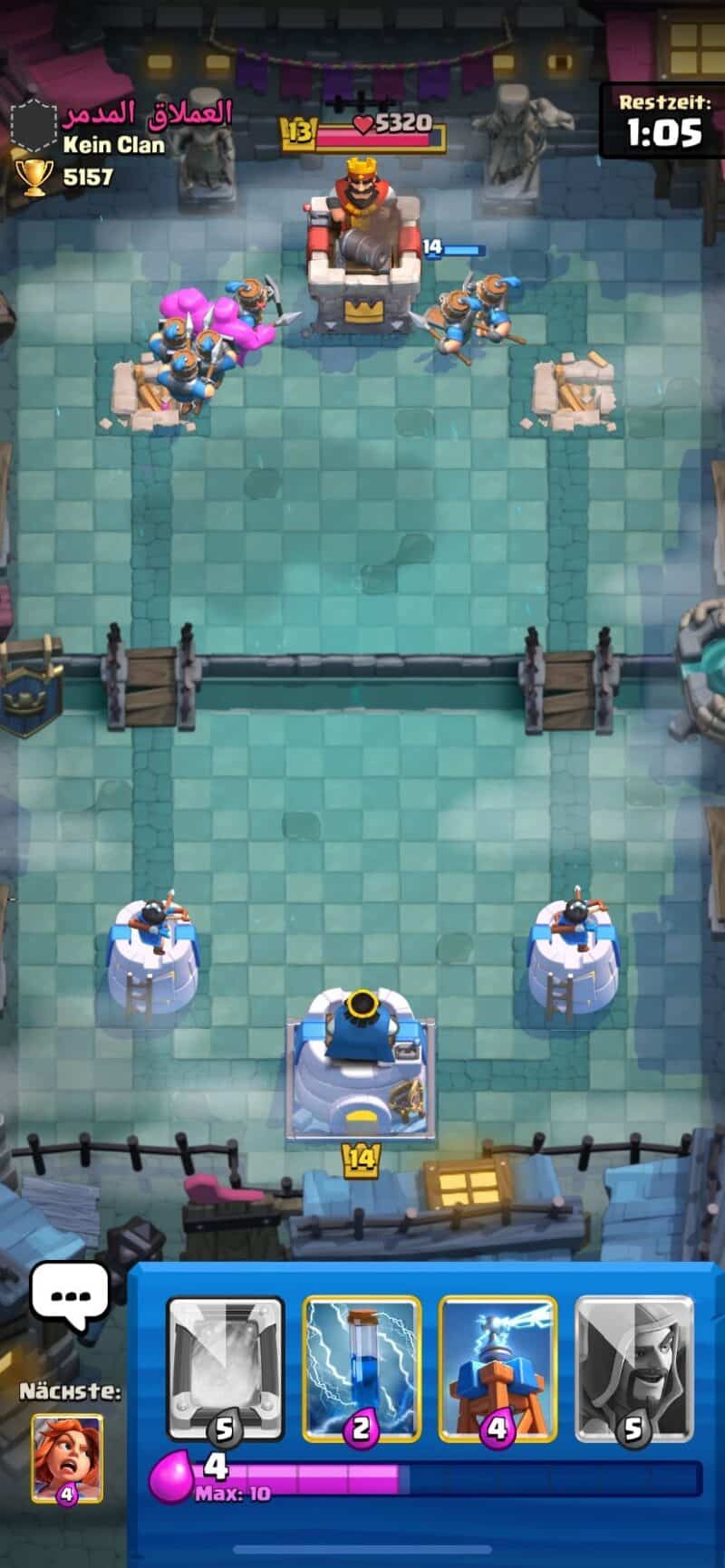Leadership: 11 steps to top performance everywhere!
Or: How we applied leadership principles from everyday corporate life to the online game. And what we learn from it – a real experiment.
Can leadership rules be applied everywhere?
If our 11 leadership principles, i.e. what we teach about successful leadership, are really that effective, then they should work everywhere, right? Is it possible to get people to perform at their best, even when the circumstances are more than suboptimal? We wanted to find out and put it to the test: 11 leadership principles in a practical test.
Leadership in the online game
Our experiment: Can we turn the anonymous players of an online game who are spread all over the country into a team? – And achieve measurable success together? Simply by applying leadership guidelines?
The conditions are extremely unfavorable:
The experiment
We report from our own experience. The events took place as they did; names and aliases have of course been changed.
Susanne has been playing an online game with her son Benjamin, a student, for a few years.
There is an online clan here: this is a group of people who compete against another online clan; not very successful in the past. People don’t know each other: everyone has an alias name and an avatar, video chats are not possible. The whole process is anonymous.
Susanne tells us:
“One evening, I’m sitting with Benjamin at a Thai restaurant and we’re chatting. We talk about our experiences in our online game and he says:
“Man, how cool it would be if our clan could finally really clean up!”.
Me: “Yes, but we’re not a team. And that’s what it would take for everyone to give their best.”
B: “I see, and how do we manage that?”
I am starting to simulate from my experience as a management consultant.
Benjamin grins. “Say, mom, don’t you want to do this for fun?”
“How?”
“Well, I’ll try out all your tips. You coach me – and we’ll see if it works”.
I have to laugh; what a funny idea! So why not?
“Deal.”
We toast each other with Singha beer.”
So here’s the story of how Susanne and Benjamin use the basics of leadership to turn a loose bunch of anonymous gamers into a high-performance team. Will that work?

Leadership versus leadership versus management: the differences
Is this about leadership or management? There are different definitions of the respective terms. Here are what we consider to be the most common definitions of the terms:
Leadership definition
Leadership that inspires and motivates people based on a vision.
Leadership Definition
Influencing people in order to achieve a (common) goal.
Often also referred to as a translation of leadership.
Management definition
Organization and control of things and processes.
Various definitions of leadership, leadership and management
Some, for example
- Königswieser, define leadership as a generic term and management (goal: order) and leadership (goal: inspiration) as its sub-areas.
- Fredmund Malik, on the other hand, describes leadership as a translation of management into German.
- Elsewhere, leadership is considered to be the German translation of the English leadership.
- Others, such as Merath, say that in most cases a manager has to appear as a leader and manager anyway.
And these are just a few examples; the words leadership, leadership and management are defined differently, but it is becoming apparent that leadership has a visionary component and management an organizing one. Although the word leadership is often used in everyday language, people prefer to use the term leadership, possibly because leadership can have negative connotations due to German history.
As you can see, there is no consensus on exactly what leadership and management mean, which is why we want to explain our understanding of them here:
Definition of leadership, management and leadership
We believe that the division into leadership, leadership and management is outdated. Manager and leader are roles that competent leadership must fulfill:
A manager who is good at talking and motivating but doesn’t have an eye on the numbers is probably just as unsuccessful as someone who works with command & control but doesn’t have their team behind them.
What we want to show in this article is that there are basic principles that can be used to motivate people in all kinds of contexts to perform at their best, which can also be measured.

What must a leader be able to do? The 7 Leadership Tasks
Good leadership, good leaders, good managers – whatever we call the people who lead a company – must perform the following tasks:
- Provide orientation
What is our vision? What is the Why? What are our goals? What is the overall context? When are we good? - Create framework conditions
Servant leadership: ensuring that the team can carry out its tasks undisturbed and carefree; that everything is organized, that responsibilities are clearly assigned. - Keeping an eye on results
Is everything running? Are we achieving our figures? Actual/target comparison, visualization of the figures for the team. - Make decisions
Or ensure that decisions are made as a team, decide together with the team and keep an eye on all stakeholders. - Being close to the people
Ensuring that the needs of individuals are heard, support & development, sparring partners. - Keeping an eye on the team
Atmosphere in the team, exchange among each other, team meetings, team organization, jour fixe. - Innovation, further development, optimization
Look at the system instead of staying in the system.
11 Leadership principles
If you search the web for leadership principles, you will find that the number of leadership principles can vary greatly: some recognize six leadership principles, others twelve. There is no fixed set of leadership principles. Nevertheless, the same principles keep cropping up, sometimes with different names and weightings.
Over the decades of our consultancy work, we have identified 11 leadership principles or leadership rules. And these are applied here.
- Mandate and acceptance
- Expectations of the team members
- Rules and consequences
- Communication
- Showing successes
- Individual services
- Fairness
- Eye level
- Conflicts
- Feedback
- Performance
In the leadership practice test, we tell you exactly what this is all about, what the background is, how we implement it in companies – and above all how these leadership rules work out-of-context:
The leadership principles put to the test
Our questions for the experiment: Do leadership principles also work outside the corporate context?
Can the findings from everyday business life be transferred to a group of online gamers? Is it also possible the other way around? What do we learn for everyday business?
These are the questions that Susanne and Benjamin want to answer with their experiment.
The initial situation
Maybe you play online games yourself more often, or maybe not. – We will therefore briefly explain what this is all about.
What is an online clan?
In some online games, you don’t play alone, but have the option of joining a clan to solve tasks together or play against another clan. The people in the clan generally don’t know each other. You will be contacted with an alias name. Photos, videos or audio are excluded here. There is no option to talk via headphones, as is possible in some other games. A conversation is not possible here!
The only direct contact option is a chat function. So nobody knows who they are dealing with: No face, no voice, no name, no information about the person.
Only in exceptional cases do players know each other personally, such as Susanne and her son. Since all of this takes place in the digital world, everyone is (alone) on their cell phone or computer and everyone is spread out across the entire German-speaking world. More anonymity is hardly possible.
What does an online clan do?
That depends on which games are played. The clan we are talking about here takes part in clan games every few days. These can be compared to tournaments. Here – what a surprise – they fight against other clans. In this case, clan games last four days. Every clan wants to win and performs together to score well. The clan only gets new tools through winnings so that it can fight even better and advance to higher levels. Of course, this only works if everyone joins in and pulls together. That’s not so easy if you don’t know the others and if no one takes on a leadership role…
Susanne:
“Nothing happened in our clan. No one joined in; nothing was happening. And that annoyed us. That’s how we came up with the idea in the first place: how do we get a group of people to work together and perform well? – After all, that’s an issue that we encounter all the time in everyday business life.”
People in Susanne’s clan don’t know each other, the clan members have little contact. Everyone hides behind nicknames. The chat function is hardly used “except for silliness or to get on each other’s nerves”, says Susanne. The clan rules, i.e. that everyone has to take part and achieve a certain number of points, do exist, but they are ignored. There are no consequences. Motivation is not particularly high: most people simply don’t take part. The clan lies fallow; too little to live, too much to die.
When personal rewards for individual achievements are on the horizon, some still get up for it. At most 30% of clan members show any form of activity at all. Team rewards are guaranteed not to be earned in this way. That’s why the clan always reliably ends up in last place in the competition with other clans: the most unsuccessful team of all. Congratulations to you. It doesn’t get any worse than this initial situation.
So how do you get from flop to top?

1st Leadership Principle 1: Obtain mandate and acceptance!
The beginning
The plan
Susanne and Benjamin come up with a plan:
“We are aware that we cannot simply impose ourselves on the clan members. We need a mandate and acceptance. My son Benjamin will take on the creative role, i.e. influence the situation. I coach him with my experience from the business world and we see if he can manage it.
There is currently a clan leader, but he has not really fulfilled his role so far and has tended to keep a low profile. There are also many people in the clan who have been there longer than us, some of them founding members. A few people know each other.
What helps is that Benjamin has performed well in the clan games: He is relatively high up in the clan ranking, in the good midfield and has consistently participated. We have to approach this carefully. It needs some kind of coordination, acceptance on the part of official and unofficial leadership.”
Increase presence
Susanne and Benjamin haven’t been in the clan that long, haven’t founded it and haven’t been able to earn much trust yet. Seizing the mandate in a rush would come across as a hostile takeover. And that would definitely not motivate anyone. The order of the day: a cautious approach.
Here we go:
Benjamin is slowly increasing the quantity and quality of his communication: not only is he a constant presence, he also encourages and motivates the others to take part in the clan battles. He addresses the issue of performance. He does not start with 100%, but slowly increases the frequency of his contributions. He also points out the existing rules from time to time. However: carefully from the role of comrade and not as a would-be boss.
The request
He wants to impose consequences for poor performance. In other words, anyone who doesn’t take part will be kicked out. Of course, he can’t just do that. After he has already shown some activity, he asks the clan and also addresses the current clan leader and the founding members of the clan. Is it okay for everyone if he takes on the task? The founders and the leader give the green light. As usual, not much comes back from the clan, but the few respondents also give him the okay. There’s not too much to lose apart from last place…
The first mandate
Benjamin therefore received an initial mandate from the people who could have officially or unofficially laid claim to the leadership. These include the best players, the oldest players, the longest-serving clan members and members in special positions.
Benjamin is responsible for ensuring that the existing rules of the game are adhered to. Even now, he does not impose consequences on his own authority. It has not yet been clearly defined when someone has to leave the clan. Benjamin proposes in the chat to remove someone from the clan who has not been online for 4 days without notice or who has not participated in the clan games during a combat phase (4 days).
Leadership in everyday corporate life: How to initiate leadership?
This is also important in everyday life as a manager: how do you gain acceptance, the mandate to lead your team?
Sure, you got the mandate from an official body: you were appointed to the management position. But this does not mean that you automatically receive a mandate and acceptance. Maybe you are a lot younger than the people who have been working in your team for a long time. And they first take a critical look at your skills and don’t want to be led by a newbie.
How do you manage to become a team leader?
How can you apply the leadership principles here? – Of course, it is important to clearly take the lead. But: please don’t go from zero to 100! Taking them by surprise and playing the boss is counterproductive and is more likely to earn you resistance than acceptance.
- If you want acceptance, then first accept and respect those who are already there! You can do this by letting them tell you how “things are going here”. Or ask them for their opinion.
- Recognize their seniority: they may have more knowledge and experience than you! The key here is to maintain a balance between listening and still staying in the lead.
- The younger you are, the less experienced you are and the shorter you have been with the company, the more important eye level is. Sometimes it also helps to address precisely this dilemma: “I know I’m much younger and still new to the company. Nevertheless, I am now a team leader. – How would you like us to deal with this situation?”
How leadership doesn’t work:
- Extreme change of direction: you arrive and suddenly everything is supposed to be completely different than before. Because you say so. Point.
- Not recognizing unofficial structures: “I don’t give a shit who is appreciated here for their skills/teamwork etc., now I rule.”
- You don’t give a damn about acceptance.
- You are convinced that you are now a leader and that everything has to listen to your command. “Adapt to me!”
Unofficial leadership
You need the leadership mandate of the unofficial leaders that every team has. Who could that be?
The more traditional a company is, the higher the value of age, affiliation and expertise. In younger teams, values other than seniority are often decisive for unofficial leadership positions: what counts here is whether someone is fast and flexible, has good ideas or can contribute a lot; in this case, you should ideally take the lead in an organizational and moderating way.
Leadership = role model function
As a leader, you stand for the rules – for this reason alone, you should always abide by them yourself! Gaining advantages and exceptions based on your position will certainly not be rewarded with respect and trust from the team. Preaching water and drinking wine has never gone down well.
Leadership tips to get your team’s mandate:
1. take on your role!
2. show respect!
3. act at eye level!
4. be a role model!

2. leadership principle 2: Get the expectations of the team members!
The team
Step number two: Benjamin has the clan’s mandate, what does he do with it now?
Susanne advises him: “We first need to find out what the team expects: What do they expect from leadership?”.
Benjamin has taken on the leadership role by carrying out all the leadership tasks. He heard that there was talk of “Benjamin leading the clan”.
He starts a survey via chat: “If I take on the role of leader, what do you expect from me? What do you want me to do?”
Answers come promptly. What we didn’t expect: many are demanding consequences. “If someone doesn’t participate or is no longer online, then there must be consequences. It’s not fair!”, “Some people do a lot and others do little. And somehow it doesn’t seem to matter. That has to change!” “It can’t be right that someone bullies others in the chat and it just goes through.”
Leadership in everyday corporate life: expectations of leadership
We recommend that anyone in a management position should ask their team: What do you want? What do you expect from me? This shows that people are important to you and that leadership is not just a hierarchical position to boost your ego. You accept a mandate and that means serving the team in the spirit of servant leadership. If you ask, everyone has the chance to say what is important to them at eye level. Of course, you should keep your ears open and be receptive to what your team brings to you.
Leadership tips to catch up with the expectations of the team
- Conduct such a survey when your time in leadership begins. You can also do this bilaterally and have a one-to-one discussion with each of your employees to compare their wishes and expectations.
- Ask for feedback again after about 100 days: What went well, what didn’t? Has anything changed? Are there other expectations? You can organize this as a workshop in which everyone can write their points on pieces of paper, but of course one-on-one discussions also work here.

3 Leadership principle 3: Ensure clear rules and consequences!
Realize expectations
Susanne and Benjamin implement the clan’s expectations: Benjamin sets the rules. Of course, many clan rules already exist, it’s just that nobody sticks to them.
It is also not the case that nobody in the clan knows the rules, on the contrary: if someone wants to become part of the clan, he or she is given the rules to read at the beginning and must expressly agree to them. However, as no one has yet bothered to comply with the rules, no one is bothering to follow the rules. This is now set to change.
Communicate rules and consequences
Benjamin announces in the chat that he will now ensure that the rules are adhered to.
The new rules: anyone who is not online for four days must unfortunately leave the clan. It’s the same with people who don’t take part in clan games. The background: the clan is there to be active together and not to pile up carcasses. And that is exactly what the few active members have expressed.
The rules are stated again in the chat. And that leads to good results pretty quickly:
Follow through on consequences
Permanently inactive members are kicked out; others who were only slightly active suddenly become more active so that they can stay in the clan. Benjamin praises activity. Inactivity and activity are suddenly seen and named. And activity now means success. And that’s not all: it’s fun. Now it’s no longer a case of everyone muddling along on their own, but doing something together. And that’s actually the point.
After Benjamin has started to sanction inactivity and praise activities in the chat, the team members gradually join in: the chat comes to life. Others also praise their team members for good performance.
Leadership and conflicting values
Then a new member appears. His nickname is misogynistic. That is why we do not want to repeat it here. One part of the clan calls this out and demands consequences, while another part finds it kind of funny. Benjamin initially holds back to see how the team deals with it. He realizes that his leadership function is in demand here and finally gets involved. He has a very clear position: anyone who makes racist, sexist or in any way degrading or inhuman comments or behavior will be kicked out. The clan does not tolerate such attitudes. The member will be removed.
Establish rules together
This is discussed in the chat. The conclusion is reached that degradation makes neither the world nor the clan better and Benjamin’s clear stance is included in the rules.
This shows:
The leadership of the clan is not solely responsible for the rules. The members can all discuss and draw up the rules together. Leadership here means ensuring that they are adhered to.
Leadership in everyday corporate life: dealing with rules
Who makes the rules?
Even in a company, the boss does not have to make the rules alone. Sure, there are already some rules. The employment contract stipulates how many hours someone works and when. But other rules can and should be set by the team itself. For example: How do we treat each other? What is okay, what is not? However, it is very difficult for team members to demand compliance with the rules. They quickly become the bogeyman among their peers. So you have to do that…
Leadership means ensuring compliance with the rules
- Create a platform that enables the team to discuss compliance with the rules. Such a forum can be a retrospective, for example: After a certain period of time, the team comes together and sums up how well the rules of the game were adhered to.
- Or you as a manager can give feedback yourself. For example: “We agreed that we would start work at 8:00 a.m., but you have now turned up at 8:30 a.m. several times. Please stick to this rule!”
Ensuring fairness
Car mechanics are a good example of this. In many garages, they are allowed to repair the cars of their first-degree relatives, but not to make their entire circle of acquaintances happy with free or low-cost repairs. That would be competing with your own company or possibly setting up your own black business. If someone does not adhere to this, then the management must intervene. Otherwise everyone else who abides by the rules will feel disadvantaged. Rules must apply equally to everyone. Otherwise there will be dissatisfaction in the team.
Claim performance
The same applies to performance. If someone consistently underperforms, doesn’t make an effort and practices easy going, then managers have to intervene. Especially when there is team pay, performance must also be demanded. People want justice and are rightly annoyed when someone breaks the rules and yet enjoys exactly the same privileges as everyone else who abides by them.
One of the trickiest points for self-organized teams
Incidentally, this topic is particularly challenging for self-organized teams that do not have traditional leadership. Here, too, it is crucial that the team finds a way to deal with team members who do not adhere to agreements or do not contribute to the team’s success. It’s difficult because nobody wants to be the bogeyman and blacken the other person’s name. But if such issues cannot be discussed, a team quickly becomes dysfunctional.
Leadership tips for dealing with rules
- Create clarity about existing rules!
- Negotiate new rules together, if possible!
- Make sure you follow the rules!
- Initiate feedback (rounds)!
- Sanction violations!
- Ensure fairness!

4th Leadership Principle 4: Establish communication in the team!
Opening up paths
As we mentioned at the beginning, there is no communication with each other in the clan. The conditions could not be more difficult: apart from a few shots, the people have never seen each other. This cannot take place because there is no video function. There is also no audio function, only the chat. There aren’t even any profile photos or real names. – But: it takes communication to generate trust and create a team feeling. You can’t do without it.
It is hard work to establish communication here!
Someone has to start!
Benjamin begins to express himself more and more in the chat. He praises and appreciates. Elsewhere, he tells us a bit about himself, for example why he took the lead here: He plays in another online game and the clan works very well there. He really enjoys it. And he wishes the same for this clan. Because he finds it sad that it has dragged on so far. And that is why he is committed. He has a positive vision.
And lo and behold!
From the remark to the conversation
– As Benjamin shows himself and regularly asks the clan questions, more and more reactions are gradually coming in. One smiley, one word.
In the beginning, Benjamin has to put up with the fact that the response is initially restrained.
But gradually conversations begin.
For example, if a member posts that they will be away for two weeks, Benjamin asks: “What’s going on?” “I’m on vacation “Oh, how nice – where are you going?” “Italy.” “Nice, have a pizza for us!”
Benjamin is responsive to the people in the clan and attaches great importance to respectful interaction. Gradually, more and more people are opening up. The nicknames are suddenly given an identity. A team feeling develops.
Leadership in everyday corporate life: creating the basis for communication
Communication is the basis for any sense of unity!
Especially in the virtual world. When colleagues see each other every day and work together, communication usually comes naturally. But when people work at different times, in different places or on different tasks, or the group gets bigger, there has to be someone to facilitate communication. There are several ways to do this: these can be regular jours fixes, weekly meetings at the start of the week or short daily meetings at the beginning of the day. Depending on what frequency your team needs.
Unofficial communication
It is not enough for the manager to say a few words and order what is to be done next. It is important that unofficial communication also takes place; conversations about what is on the individual’s mind, what is going on in their life at the moment, both privately and professionally.
Tip:
Start every team meeting with a flash in which everyone can say a few sentences about how they are doing and what is currently occupying them professionally and privately.
Community = communication
Why? The more of the person you see, the more of a team feeling there can be. If you know your colleagues and know something about them, then you are more likely to help them. People are social beings and need community. Only when there is mutual openness can trust develop and synergies take effect. This improves cooperation. That is why communication with each other is so immensely important.
Leadership = communication
Leadership here means asking yourself: What needs to be communicated? What does everyone need to know?
The more transparently you communicate the big picture, the goal, the vision, what is going on and show yourself as a person, the more often you give feedback, the more you will not only stimulate communication and trust, but also the passing on of information.
Personal exchange in the virtual world
The importance of personal interaction has been impressively demonstrated to us all during the coronavirus pandemic and lockdowns. We have learned how important it is to give time and opportunity for personal exchange in video conferences. In the companies we support, for example, there was a virtual coffee kitchen or a team evening where colleagues met online in the evening for an after-work drink to chat a little, as if they had gone to the pub together. Of course, this is no substitute for meeting in person or going to the pub, but if there’s no other way, it’s definitely better than nothing. It was – and still is – extremely important to know how others are feeling, to listen to them and to contribute something personal. Our experiment also shows this. So take your time, because it makes a big difference!
Leadership tips to get communication going
- Initiate regular communication!
- Create opportunities for unofficial communication!
- Show yourself, be open!
- Question!
- Plan communication!
- Talk about your vision!

5th Leadership Principle 5: Make successes visible!
Turning a team into a successful team
The people in the clan have become active, they chat with each other and keep to the rules. A team feeling has developed. The foundations for success have been laid.
Benjamin and Susanne are now concentrating on setting a course for success:
The two want to spur on the ambition of the clan members by showing what the team has already achieved. Of course, this information also shows what has not yet been achieved and where the journey can still take us. Direct feedback for success helps to achieve top performance.
Showing successes
In the online game, four-day battle phases alternate with four-day training phases. After each battle phase, Benjamin thanks the participants and honors the best performances. It shows how many people took part, how many achieved the minimum number of points, but also how many achieved a particularly great result with over 2000 points. And, of course, the team finds out the ranking – and there is increasingly good news: More and more often, the clan is in one of the top places.
But communication of the results is also important during the combat phase. After each of the four days of fighting, Benjamin announces the results in the chat: “Great, we came third today!” or “We came second, but our competitor is only just behind us!”
The participants already have the information as such – but the visibility that Benjamin creates in this way generates resonance. The clan is happy, motivated – and has sharpened its focus.
Leadership in everyday corporate life: seeing success
Motivation is a well-founded expectation of success. In this respect, it is advisable to make successes that have already been earned visible.
Every team should think about this: How can we make our successes visible?
In lean management, it is recommended to hang up boards with the current status of the team: for example in production – how long the team has been working without errors or how high the quality is. There are key figures here. Our experience is that a team performs significantly better when performance is made visible. When everyone can see what’s going on.
A good example: a sales manager built one Lego brick on top of another for every car sold. This allowed the team to see at a glance that things were perhaps a little better in one month and a little worse in another.
How to make successes visible
Answer the following questions:
- What do you have that you can make visible? It must be measurable.
- How can you measure whether you are good?
- What are your KPIs?
- How do you make sure that everyone in the company always knows what the current status is, what is going on and where everyone still needs to stretch themselves?
If only the boss has the relevant figures and is keeping quiet about them, then everyone is working away. That is demotivating.
Leadership tips to demonstrate success
- Ask your team how you can make your successes visible!
- Work through the questions (see above)!
- Make sure that the success visualization is also running!

6 Leadership Principle 6: Individual performance must also be recognized
Recognition for individual achievements
The last step has shown: It is important for the ladies and gentlemen of the clan that their achievements are also seen. So Susanne and Benjamin go one step further: Benjamin takes the time to write to each individual after a performance. “Great, this time a total improvement on last time. It’s great that you’ve worked so hard. It was really worth it!” or “Yasmin, Leo, Alex – you reached the top of the clan battle, over 3000 points. Hammer!”
The people addressed soak up the praise like a sponge. This is all too human: none of us can free ourselves from the fact that it is important to him or her to be valued and treated with kindness.
Demand in the absence of performance
Benjamin not only discusses the outstanding performances, but also asks when someone pulls out and doesn’t take part: “We’re already on match day three. You are missing. – Is everything clear with you? How is it going? What’s going on with you right now?
The fact that it is clearly visible when there is no power means that it is no longer easy to dive or sag. And so many still go off and take part in the clan games.
Leadership in everyday corporate life: individual performance versus team performance
In everyday business life, it is important to see and name individual performance. But be careful!
Don’t emphasize individual performance at the expense of team performance!
Be aware that if you praise individuals, others who have worked just as hard may feel overlooked. They may not have achieved the same success, but they gave their all. In this respect, it could be very demotivating for her: “Now I’ve really stepped on the gas. And yet I’m not achieving anything. Then I might as well give it up.” People have different strengths in different areas. And it would be a shame if someone who has given a good performance but is perhaps not quite so well positioned in this area were to fall behind, not be seen and feel disadvantaged as a result.
The thing is tricky! You have to weigh things up carefully. After all, it is just as demotivating if someone delivers an outstanding performance and this is not recognized, but he or she is lumped together with everyone else. That would do neither the cause nor the people justice. Your sensitivity is needed here!
Performance and task
The performance you see always depends on the task, of course. In today’s business world, many tasks are so complex that the performance of an individual does not significantly advance a task. It is usually necessary for many people to knit a stocking. Sometimes several teams even have to work together to ensure that the project makes progress. Often enough, some people work on the front line and others in the background. Leadership here means seeing and praising everyone’s performance. As a manager, you should of course not only praise the successful salesperson, but also the administrative staff who made the sale possible in the first place.
The extra mile
It is particularly important that you praise your employees when they have gone the extra mile. Take the example of a car repair shop: someone has gone the extra mile to fulfill the special wishes of a regular customer. Or if someone has worked late so that the truck can be finished that evening. If someone has often gone the extra mile and arrived at their family home late at night – you have to see that! You can’t take that for granted. In this respect, you have to comment positively!
Praise rules!
There should be no shortage of praise. It is not a resource that will run out at some point and no longer be available to you. So you don’t need to skimp on this!
There are managers who have a somewhat bony attitude to praise: “Not scolding is enough praise” or “Should I praise them every time now, simply because they do the work for which they are paid?” or “Just don’t go overboard with the praise, otherwise people will become conceited”. We cannot support these attitudes. We think that is absolutely wrong. Ultimately, this has a counterproductive effect on motivation and performance. Of course, you should approach your people with well-founded praise and not praise for praise’s sake. When people make an effort – you have to see it!
Appreciation
Without appreciation, your work will not be appreciated. Especially in times of skills shortages, it is not a given that people will make an effort. You can find work anywhere. And even if they don’t leave the company, they may just be working to rule. Because: “It’s no use trying”. So appreciate and praise the work and effort of individuals, the team and also the people in the background!
Leadership tips for valuing performance and team performance
- Praise a lot!
- Balance individual performance and team performance with sensitivity!
- Also look at the performance / people in the background!
- Comment Extra efforts!
- Give concrete and well-founded praise!
- Don’t take performance for granted!
Leadership principle 7: Fairness and justice
Fairness
Something happens in the clan that Susanne knows from her everyday life as a management consultant: when the berlin team conducts surveys on values in companies, the topics of fairness and justice are usually brought to light. Because when people get the impression that they are being treated arbitrarily, unequally and unfairly, they become enormously unrelaxed. Animals too, by the way, which has been scientifically proven. Everyone wants to be treated fairly. The clan is no different: the clan members demand justice!
But what happened?
The rules of the game
First of all: there is the option of awarding titles in this game. And skills are also linked to the titles. A member is not allowed to do anything. An elder more so. And a vice can kick out everyone else except the leader.
A person, let’s call him Rookie, joins the clan. His goal: to become a clan elder as quickly as possible.
There is already a clear rule for this, which Benjamin has established together with the others:
If you reach a certain number of points in the clan battle in two consecutive clan phases and perform regularly during this time (about 2 weeks), you can quickly become a clan elder. Anyone who fails to perform over two clan phases will be downgraded to a normal member again.
The rule is clear: certain benefits bring certain advantages. Or even clearer: no performance, no reward!
The challenge
But then comes Rookie. Rookie starts a discussion: “The game is so important to me! Look: I did a great job in the first phase of the match. I’d really like to be the oldest.” The response: “No problem, bring the performance again in the next phase of the fight and keep it up.” But Rookie struggles with this rule: “But it’s so important to me that I’m already the oldest. Can’t you make an exception?”. Rookie is much tougher when it comes to arguing than when it comes to performing and doesn’t back down a single meter. Susanne and Benjamin are already thinking about whether someone wants to take the mickey out of them.
The consequences of inconsistency
To save time and nerves and end the unpleasant discussion, Benjamin could have said: “Never mind, it doesn’t cost any money. That’s all right, let’s leave him alone.” – But: everyone else would be put off by this; everyone who follows the rules and works towards such a goal would be put off! The distinction of becoming a clan elder through performance would be devalued. Arbitrary distribution would create the impression that you can no longer rely on the fact that if A, then B. Ultimately, motivation and morale would be thoroughly damaged. Because if it’s not your own effort that wins you an award, but the whim and arbitrariness of the person handing it out, then you might as well not bother.
Susanne and Benjamin put the exception in the clan up for discussion. The clan decides unanimously that rules must be adhered to. Bam.
Leadership in everyday corporate life: equal treatment
Unequal treatment in companies
In everyday corporate life, fairness is not just a value that comes out in surveys or is written on the website. We have already experienced unfortunate situations where people have not followed the rules, behaved badly or even rudely. And the managers did not intervene, did not even comment on the misconduct. Of course, the employees are aware of this. Often, managers do not enforce the rules because they are dealing with a workforce that they do not want to lose.
Of course, it gets even worse when others are expected to follow the same rule, but not certain people.
The diva and the normal people
Henning is a top salesman at the dealership. He speaks with the tongues of angels to his customers. However, he treats the women who work in the company like his servants and behaves in an almost militarily rude manner towards younger employees. He gains advantages, but when there is more work to do, Henning is nowhere to be seen.
Or Theresa, who has a special position in the company thanks to her expertise. Theresa is always late. When Kaya arrives late, she is immediately reprimanded. The fact that Theresa strolls in the door much later on the same day is deliberately ignored. It’s better not to cause Theresa any trouble – she’s too important.
Leadership means equal treatment
Such unequal treatment leads to turmoil and dissatisfaction in the team. Therefore, treat your employees equally, otherwise people will feel left behind.
It is also inappropriate to hand out benefits and praise because the manager and employee get on particularly well. Even if you might think: “Employee X is particularly nice to me, I’d rather spend time with her than with annoying Y” – that’s not possible.
The same basics for everyone. No lord of the manor style!
And no team member is so important, no performance so irreplaceable, that you can afford to undermine the morale of the entire squad.
Leadership tips to treat everyone equally
- Enforce the rules!
- Don’t make any exceptions!
- Pay attention to equal treatment!
- No lord of the manor style!

8 Leadership principle 8: Eye level – discuss decisions in the team!
Leadership and eye level
Benjamin is one of the good and reliable players. He achieves high scores, but is not the best. And yet he has taken on the role of leader in the clan. He has been given a mandate by the clan to do something for the clan. If, as a manager, he were to suddenly start making decisions on his own and playing the decider, a bad mood would quickly arise. That’s why Benjamin’s leadership role is that of a moderator who pays attention to the rules, but doesn’t make all the decisions alone. Important things are always discussed in the whole clan.
Who deserves which rank?
For example, the question: At what point do you become vice? To explain this again briefly – there are different ranks: Member, Elder, Vice, Leader. The position of leader is held by Niklas, who founded the clan. However, Niklas doesn’t have much desire or time to be active for the clan and doesn’t make much of an appearance. That’s fine for everyone. The fact that he holds this position is clear from the history of the clan. Nobody is shaking that up.
How to become vice champion has not yet been precisely defined. Benjamin makes a suggestion in the chat: “You become vice champion if you score more than 2500 points more than five times in a row,” i.e. if you complete at least five battle phases with an extremely high score. Clan members express doubts: “As vice you have more rights. For example, you can kick other people out. But just because you’re good at gambling, it’s somehow not right to kick others out.” Others comment: “Exactly! We don’t even know if the person is reliable. Just because someone scores points doesn’t mean they’re behaving well.” The majority of members are in favor of the idea that only a clan member with integrity who has sufficiently proven their reliability should be appointed to the (power) position of Vice President.
The better idea wins, not your own
Benjamin revises his proposal. This is very important for the clan. He doesn’t take the lead and make decisions over everyone’s heads, instead everyone thinks together. No one is better than anyone else. Leadership here means the mandate to represent, channel and organize the interests of the clan. Benjamin is in the service of the clan; and not the clan in the service of Benjamin.
Leadership in everyday corporate life: servant leadership
There is a lot of talk about servant leadership. This means that the manager sees himself as a “servant” of the team and removes all obstacles from the team’s path so that the team can complete the tasks for which it was hired. Furthermore, the manager is more of a moderator than a decision-maker and moderates the opinions of the team members on a decision. This attitude is basically a well-functioning, modern way of perceiving leadership, but it is not a panacea either. There are many different leadership situations, so servant leadership cannot fit everywhere.
Hierarchical management style
For example, there are also highly hierarchical company structures where this fits in perfectly. We got to know a craftsman’s business where the senior really knows his stuff. A lot of young people work here – and they swear by it. “That’s fine! Let the senior make the decision. He knows what he’s doing.” In this team, the employees are extremely satisfied with not having to make decisions themselves. On the contrary: they are even happy to leave this task to the boss. They want instructions on what to do when, where and how – and then carry them out. As you can see, even highly hierarchical structures are justified and can work wonderfully. It depends on the task, the people and the constellation. In this respect, it is not easy to decide from a distance whether servant leadership is appropriate in a company or not.
Modern leadership
However, leadership as a servant leader is more contemporary. The manager goes into the lead, not because he or she is better, has the higher position, is the smarter, older, more educated, but because someone has to take on the role and the person can also fill this role well. The role of servant leader is performed on an equal footing: Decisions are made in the team, for example by majority decision or other forms of decision-making. Ideas are tried out as long as there is no veto. Leaders moderate, coordinate and organize in a similar way to Scrummasters.
Because the more complex the task, the less likely it is that the manager is the smartest person, the person who solves a problem alone. It takes all the brains in the team. The management must ensure that everyone can do their job well. Theoretically, anyone can do this job if they have the basic requirements.
Leadership tips for working at eye level
- Does servant leadership suit your team?
- Which forms of decision-making are favorable for you?
- How can you keep your team motivated to do a good job?

9 Leadership Principle 9: Dealing with conflicts – don’t let conflicts run their course!
Quarrels and disputes
Where there are people, there is trouble. Sooner or later, conflicts arise and people get into each other’s hair. That is completely normal. And of course our clan is no exception:
Suddenly, members start bitching at each other. “You’re showing off!”, “Well, you’re not good at it anyway!”, “Well, with the spelling mistakes you make, you don’t need to tell anyone here anything.” People exchange vulgarities with each other, mob each other and create a toxic atmosphere. That can’t be good for the clan.
Intervene in the conflict
Benjamin has to intervene. For topics that can be discussed objectively, he states the facts to set the record straight. He responds to the rampant belligerence with an appeal: “We are a clan. Don’t beat each other up! – I don’t want to see any fighting here! You both have arguments that I can understand. As a clan, we are only strong together. That’s why we have to stick together. The first step is for you to try to understand each other.”
Not an easy undertaking… The options for conflict mediation are extremely limited: after all, there is only the chat. The clan is also extremely diverse in terms of age – there are twelve-year-olds as well as parents of adult children.
All Susanne and Benjamin can do here is try to break up the quarrels, calm them down and prevent the conflict from escalating.
Leadership in everyday corporate life: resolving conflicts
It goes without saying that the same applies to day-to-day business: never let conflicts run their course! The situation is of course more complex: the performance pressure is usually relatively high. People with the most diverse backgrounds, motivations, perspectives and preferences come together and often have very different tasks to perform. Of course there are conflicts. On the topic of constructive conflict resolution
we have written a comprehensive article that can certainly help you with conflict resolution.
Leadership and conflict
The easiest thing for you to do would be to look away and say: “It’s none of my business, let them do it”. Sure. But: the mood of the entire team is at stake. When a conflict arises, the people around it will feel uneasy. It is also to be expected that the disputants will not work together particularly constructively and successfully. They will talk less, avoid each other, not support each other. In this respect, the team’s performance is also at risk. So if it comes to your attention that there is a conflict going on in your team – you have to act!
What do you do as a leader when you are involved in a conflict?
Of course you can’t interfere and take sides. That would not resolve the conflict. That would cause even more bad blood.
- Your first step: talk to the parties involved in the conflict and ask them to resolve it together. Offer: “If you can’t do it, please come to me!”.
- Of course, you now need to keep an eye on whether this conversation actually takes place and whether the parties involved are able to come to a constructive solution.
- If the dispute persists, initiate a conversation in which you are also present. Your task here is mediation:
- Summarize both points of view!
- Name what connects them!
- Point out the differences!
- Explain that it is natural and understandable to disagree.
- Express your understanding to both sides!
- Question: “How do you want to resolve this so that both feel they are being treated fairly?”
- Is everything not working? Then it’s time to bring in an external mediator.
- Didn’t help either? If possible, separate the disputants!
Leadership tips for conflicts
- Be vigilant and try to be aware of conflicts!
- Take action, don’t let conflicts run their course!
- Do not take sides!
- Take over the mediation if necessary!
- Seek external help if necessary!
In this video, Susanne gives you tips on how to resolve conflicts.
10th Leadership Principle 10: Feedback and learning
Leadership means accepting feedback
Susanne and Benjamin think it is important to establish a culture of learning and feedback in the clan. The atmosphere in the clan should enable feedback to be given and accepted through goodwill and openness. They ponder how they can manage this. They decide to start with themselves:
Benjamin asks for feedback on his leadership position in the chat. “How are you doing with my work as clan leader? What suggestions do you have for improvement?”. Benjamin receives a lot of praise. In addition, there are one or two tips on how he could perform his function even better. One member expresses his annoyance. Benjamin reacts openly: He asks what exactly the issue is and what specifically he can improve. He says thank you “Great, thank you for being so open – we can do it that way.”
Feedback within the team
The next step is to create the possibility of feedback everywhere within the clan.
By chance, a situation arises where one clan member gets upset about another. Benjamin asks the clan for feedback: “Please tell us what you think. How should we deal with the situation?” He asks them to treat each other with respect and to give benevolent and constructive feedback, because after all, no one benefits if a clan member is put through the ringer. That works well. Both opinions are respected and this creates an atmosphere of openness.
Benjamin always asks for feedback. This ultimately strengthens the team feeling: everyone can express their opinion and is heard.
Regular feedback
Benjamin uses the resulting feedback culture to intensify his feedback. After each tournament phase, he gives a detailed evaluation, names the people, praises successes and deals in detail with opportunities for improvement. He gives appreciative feedback, even when the performance is suboptimal: “We have 16 fights in the combat phase. You only took part in one. That’s not the performance we need here in the clan. Do you want to be there or not?”
At the same time, he considers when he has to go through with the ultimate consequence – clicking someone off – and when he should give the clan member one last chance. Anyone who has participated a lot for a long time and doesn’t take part is first asked in a friendly manner what the reason was.
Leadership in everyday corporate life: error and feedback culture
In companies, a culture of feedback and dealing openly with mistakes is crucial for the performance of the team.
Error culture
If every mistake is penalized, then nobody dares to try something new and gets stuck in the long term.
Leadership feedback
Leadership here also means asking for feedback yourself. This can be done individually or in a group. Your challenge as a leader: accept feedback openly and appreciatively! Thank people for speaking out. What you should never do is justify yourself and your actions or start discussions. Ask comprehension questions so that you know what behavior is involved and what exactly your counterpart needs. Your team should feel accepted when they give you feedback.
Regular retrospectives
Put your foot on the ball every few weeks and discuss together as a team what went well, what was good and where there is still room for improvement. Discuss how you want to approach optimization. This strengthens the feedback culture. Because once feedback has become routine, it is no longer a big hurdle to address difficult topics. Through regularity, the team gets into a flow with each other and gains a self-image that it is completely normal to talk about things and to be talked about.
Generations Y and Z
Members of the younger generations in particular are used to feedback. In online gaming and social media, it is normal to get reactions. Give regular, if possible even daily feedback!
Leadership tips for feedback in the company
- Familiarize yourself with the feedback rules! (E.G. through our feedback article)
- Get feedback!
- Accept feedback!
- No justification, no arguing!
- Set up regular feedback rounds!
- If something goes wrong, speak up right away!
Here are a few feedback tips from Susanne:
11 Leadership Principle 11: Commitment counts, not age or experience
There are students in the clan, there are parents and there are also grandparents. They are all taken seriously. No matter who makes a contribution or gives feedback, Benjamin gives everyone the same attention. Every opinion counts the same. A student who has no time because he is studying for a class test is treated with the same understanding as a nurse who had to work overtime on the night shift and therefore could not attack. Even someone who behaves childishly or someone with very pronounced spelling difficulties – everyone receives a friendly response that makes them feel taken seriously.
Leadership in everyday corporate life: Diverse team
In online gaming, it’s completely normal – but in business, it’s a total game changer: company affiliation, age, degrees no longer determine whether someone is seen as the one who automatically contributes the best solution. Others are also taken seriously: even the youngest can perform superbly, for example because speed and perceptiveness are needed – and he/she has them.
Age diversity
Often enough, young people have more digital skills because they are much more experienced online, because they are fast and also deal with computers, digital and online worlds in their free time. As they often approach problems in a completely different way, they can quickly come up with a solution where older people might be standing like an ox in front of a mountain.
In this respect, it is extremely important nowadays to involve trainees as well. They also have ideas. Involving them also strengthens the team spirit. The maxim should be: the better solution is taken, no matter who it comes from.
For example, one of our clients commissioned a team of trainees to record learning videos for the change process in the company, which will help all employees. The simple cell phone videos have brought huge added value! And they cost almost nothing, as the trainees knew how to make and edit videos from their free time anyway.
Leadership tips to unleash the full power of the team
- Let everyone have their say!
- Don’t infer solution competence from age, origin, etc.!
- Use everyone’s strengths!
- Make room for people with little seniority!
In this video, Oliver talks about the different generations in the company.
The result of our leadership experiment
Of course you want to know what the result of our experiment is, don’t you? What happened? What has the clan achieved?
Week 0
Where did we start? We remember: The clan was previously a collection of people who didn’t know each other, had no connection and didn’t use the chat function for conversations. In the tournaments, the clan was reliably in last place for weeks because nobody had the leisure to get involved. Worst Case Scenario.
Week 3
After 2.3 weeks, some members joined in. This is reflected in the tournament results. Although the clan is still in the lower ranks, it is slowly working its way up.
Week 8
People write to each other in the chat, the members show each other personally “I have exams”, “I’m out of town”. Conversations arise. Friend and family relationships between individual clan members become known.
The clan is now in first place for the third time.
Week 10
Benjamin is no longer alone in the chat; feedback and comments are constantly coming in. New members join the clan “Wow! Best clan I’ve ever experienced: finally there’s a community!”. The existing members suddenly feel cool as a clan. A sense of togetherness is created.
Week 20
We have been in 1st place for 9 weeks!!!
After each of the four tournament days, the players applaud each other. If things don’t go so well, the members encourage each other. “We’ll get them!”. The clan is committed to working together.
Week 30
We are on the verge of a decisive promotion to the legendary league. With every first place, we collect important points that pay towards promotion. And as long as the record goes back, we are in first place. We are proud. Everyone in the clan is proud to be part of it. The chat is alive. We know each other. If someone is unable to take part, they apologize and promise to be back next time. Others want to join us, people are catching up with their friends. “Awsome Clan!” someone just wrote.
Our result
Yes, good leadership leads to top performance! – And to a good team feeling.
And this also seems to be transferable to completely different contexts. Even teams in really suboptimal situations can become successful through good leadership.
We see it everywhere in our day-to-day work as consultants and in a wide variety of business contexts: teams in which the leadership works, in which the team spirit is positive, are always at the top of the league in terms of performance!
Mission completed.

Read more about leadership
Not had enough yet? How can good collaboration be achieved through leadership? – We have a few more articles for you here:















